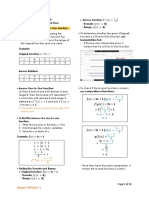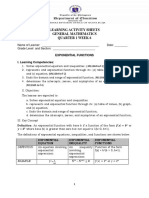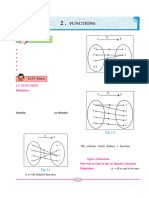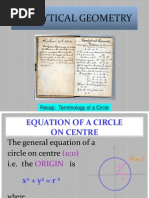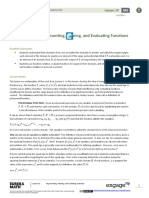g12m Functions
Uploaded by
api-235269401g12m Functions
Uploaded by
api-235269401Evaluating a Function
FUNCTIONS
TERMINOLOGY
A relation is any formula or rule that
connects 2 sets of numbers.
i.e. y = 2x + 3
Domain: all the numbers that exist for x
Range: all the numbers that exist for y
Finding the Domain and
Range of Graphs
Domain, Range and
Functions
A function is a relationship where for
every x value, there is only ONE y value
OR
A function is defined as a one-to-one
relationship
There are 2 ways to establish if a
relationship is a function
i) Mapping
ii) Vertical line test
One-to-one mapping:
Is a function
1
2
3
4
2
4
6
8
2
-2
3
4
9
2x
x
2
x
y y
x
Many-to-one mapping:
Is NOT a function
Vertical line only
cuts the graph in
one place:
Is a function
Vertical line cuts the
graph in more than one
place:
Is NOT a function
Vertical Line Test
INVERSE FUNCTIONS
A function g(x) is the inverse of function f(x)
if
the domain of g(x) is the range of f(x) and
the range of g(x) is the domain of f(x).
i.e. the x and y values are interchanged
Inverse Function Graphs
Introduction to Inverse Functions
3
3
f(x)
3
3
f(x)
Inverse of a Straight Line
y = 2x
2
is a function
We can put restrictions on
the original parabola, so
that the inverse will be a
function.
f(x)
Inverse of a Parabola
f(x)
EXPONENTIAL & LOG
GRAPHS
This should
be second-
knowledge!
Write 625 in terms of base 5
Since bases are the same
We equate the exponents
30 CANNOT be written in
terms of base 5!
?? Now what ??
We use LOGS
Interesting! The Log Scale
First interchange x and y
The base of the
exponent becomes the
base of the log
Converting Between Exponential & Log Form
The Inverse Graphs of Exponents & Logs
Solving Basic Log Equations
Sketching Basic Exponential
Graphs
Sketching Basic Log Graphs
Increasing Exponential
Graph: y = 2
x
Increasing Log
Graph: y = log
2
x
Together .
Decreasing Exponential
Graph: y =
x
Decreasing Log
Graph: y = log
x
Together .
Exponential and Log Graphs
SOLVING CUBIC
EXPRESSIONS
Finding the Remainder
Complex Remainder Problem
Understanding the
Factor Theorem
Complex Factor
Theorem Problem
Visualizing Factors &
Remainders
Calculating Remainders
given Factors
f(x) = x
3
+ 3x
2
x 3
Remainder = f( 1)
= 1
3
+ 3(1)
2
(1) 3
= 0
Therefore (x 1) is a factor
Note! f(1) did not equal zero we would
have to continue to find f(-1), f(2), f(3), f(-3)
etc until the remainder equalled 0.
1. Solve for x: f(x) = x
3
x
2
8x +12
f(1) = (1)
3
(1)
2
8(1) +12 = 4
f(2) = (2)
3
(2)
2
8(2) +12 = 0
x 2 is a factor
f(x) = x
3
x
2
8x +12
0 = (x 2) (x
2
+ 1x 6)
0 = (x 2) (x + 3) (x 2)
x = 2 or x = -3 or x = 2
x 1 is
NOT a
factor
2. Solve for x: f(x) = 2x
3
7x
2
+ 2x + 3
f(1) = (1)
3
(1)
2
8(1) +12 = 4
x 1 is a factor
f(x) = 2x
3
7x
2
+ 2x + 3
0 = (x 1) (2x
2
5x 3)
0 = (x 1) (2x + 1) (x 3)
x = 1 or x = - or x = 3
Solving Cubic
Expressions
You might also like
- Inverse Functions Inverse Trigonometric FunctionsNo ratings yetInverse Functions Inverse Trigonometric Functions38 pages
- exponentialandlogarithmicfunctions-140306230640-phpapp01No ratings yetexponentialandlogarithmicfunctions-140306230640-phpapp0129 pages
- A. Exponential Equation, Inequalities and FunctionNo ratings yetA. Exponential Equation, Inequalities and Function8 pages
- Week 005-Presentation Key Concepts of Inverse Functions, Exponential Functions and Logarithmic Functions Part 002No ratings yetWeek 005-Presentation Key Concepts of Inverse Functions, Exponential Functions and Logarithmic Functions Part 00226 pages
- GenMath LAS q1 w6 Exponential-Function v1No ratings yetGenMath LAS q1 w6 Exponential-Function v14 pages
- Training Course 9 Senior Functions and TrigonometryNo ratings yetTraining Course 9 Senior Functions and Trigonometry32 pages
- Composite and Inverse Functions practiceNo ratings yetComposite and Inverse Functions practice7 pages
- Learning Concepts and Activities: Page - 1No ratings yetLearning Concepts and Activities: Page - 16 pages
- Lecture 3 Exponential and Logarithmic FunctionsNo ratings yetLecture 3 Exponential and Logarithmic Functions58 pages
- 07 CH Chemical Bonds and Shapes of MoleculesNo ratings yet07 CH Chemical Bonds and Shapes of Molecules13 pages
- 06 PH Newton Law of Universal GravitationNo ratings yet06 PH Newton Law of Universal Gravitation12 pages
- 02 PH Addition of Vectors in 2 Dimensions 20% (1)02 PH Addition of Vectors in 2 Dimensions 212 pages
- DAILY LESSON LOG OF M10AL-Ia-1 (Week One-Day One)No ratings yetDAILY LESSON LOG OF M10AL-Ia-1 (Week One-Day One)5 pages
- General Mathematics: Quarter 1 - Module 1No ratings yetGeneral Mathematics: Quarter 1 - Module 111 pages
- General Mathematics: Online Learning ModuleNo ratings yetGeneral Mathematics: Online Learning Module17 pages
- Chap4 - Functions, Pigeonhole PrincipleNo ratings yetChap4 - Functions, Pigeonhole Principle31 pages
- Worksheet 9 Memorandum Functions Basics and Straight Lines Grade 10 MathematicsNo ratings yetWorksheet 9 Memorandum Functions Basics and Straight Lines Grade 10 Mathematics7 pages
- MATH1031 Mathematics For Life Sciences: Term 3, 2021No ratings yetMATH1031 Mathematics For Life Sciences: Term 3, 202136 pages
- Algebra 2: Piecewise and Absolute Value FunctionsNo ratings yetAlgebra 2: Piecewise and Absolute Value Functions21 pages
- General Mathematics: Functions and RelationsNo ratings yetGeneral Mathematics: Functions and Relations22 pages
- 4 3 - Does Not Intersect The Curve - 4 8 8 + - (5) : 1 Find The Set of Values of K For Which The Line y K XNo ratings yet4 3 - Does Not Intersect The Curve - 4 8 8 + - (5) : 1 Find The Set of Values of K For Which The Line y K X36 pages
- Section 0.3b Domains of Composite Functions PDFNo ratings yetSection 0.3b Domains of Composite Functions PDF4 pages
- Lesson 10: Representing, Naming, and Evaluating Functions: Student OutcomesNo ratings yetLesson 10: Representing, Naming, and Evaluating Functions: Student Outcomes13 pages
- Domain and Range of Graphs Practice Worksheet ANSWERSNo ratings yetDomain and Range of Graphs Practice Worksheet ANSWERS3 pages
- exponentialandlogarithmicfunctions-140306230640-phpapp01exponentialandlogarithmicfunctions-140306230640-phpapp01
- A. Exponential Equation, Inequalities and FunctionA. Exponential Equation, Inequalities and Function
- Week 005-Presentation Key Concepts of Inverse Functions, Exponential Functions and Logarithmic Functions Part 002Week 005-Presentation Key Concepts of Inverse Functions, Exponential Functions and Logarithmic Functions Part 002
- Training Course 9 Senior Functions and TrigonometryTraining Course 9 Senior Functions and Trigonometry
- Worksheet 9 Memorandum Functions Basics and Straight Lines Grade 10 MathematicsWorksheet 9 Memorandum Functions Basics and Straight Lines Grade 10 Mathematics
- MATH1031 Mathematics For Life Sciences: Term 3, 2021MATH1031 Mathematics For Life Sciences: Term 3, 2021
- 4 3 - Does Not Intersect The Curve - 4 8 8 + - (5) : 1 Find The Set of Values of K For Which The Line y K X4 3 - Does Not Intersect The Curve - 4 8 8 + - (5) : 1 Find The Set of Values of K For Which The Line y K X
- Lesson 10: Representing, Naming, and Evaluating Functions: Student OutcomesLesson 10: Representing, Naming, and Evaluating Functions: Student Outcomes
- Domain and Range of Graphs Practice Worksheet ANSWERSDomain and Range of Graphs Practice Worksheet ANSWERS




